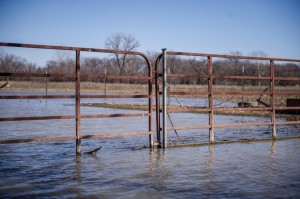Near the Kelleher/Langston home, large manmade ponds and massive holes serve as valley storage.
Flood prevention measures have been on Marshall’s mind lately. The TRWD engineer and city officials are closely examining potential sources of additional valley storage throughout Fort Worth. One promising area is near Beach Street on the East Side. The $29 million project alone, he said, should be completed in three to four years and could reduce peak Trinity River flooding by 5 percent, which translates into a reduction in the Trinity River’s flow by around 1,030 cubic feet per second. Marshall is collaborating with professors and graduate students at UTA to better predict how the Trinity River will behave in coming years.
The only public complaints about the project, TRWD spokesperson Lorance said, are about the construction traffic.
The goal isn’t to eliminate flooding entirely, Marshall said. That would be impossible. But with the proper network of valley storage locations, flooding along the Trinity River can be slowed enough to allow for the safe evacuation of residents and livestock.
“But for the big storms,” he added, “people have to be ready to evacuate.”
Newell rebuffs any notion that his projects have done anything but support the local economy and make the area more secure from flooding.
Newell’s development company, he said, has added a total of 600 acre-feet (1 acre-foot equals 325,000 gallons of water) of valley storage.
Part of that valley storage is a channel built by Newell’s company that crosses Trinity Boulevard and allows flood water to flow north into a 42-acre lake on the north side of Trinity Boulevard. The lake, he said, has enough storage to raise 12 to 15 feet.

“I’m proud of what we’ve done,” he added. “From a flooding standpoint, we are definitely improving the area.”
Davis said Newell’s description of the 42-acre lake’s ability to mitigate flooding was “mostly correct,” adding that he has no way to verify that the lake in question was designed specifically to protect the area.
Newell said he’s proud of his projects’ “positive impact” on the local economy by providing construction jobs, retail space, and housing. In the late 1990s, the Newell family donated 15 acres to UTA’s Automation and Advanced Robotics Research Institute in Northeast Fort Worth as part of the family’s commitment to “civic development,” according to Trinity Lakes’ website.
The stormwater division’s Stern said that her department has been researching the scope of the flooding dangers along the Trinity River. In a draft of the Floodplain Management Plan, completed last December by Freese and Nichols Incorporated with input from city staff in addition to local residents and business representatives, the coauthors describe the city’s vulnerabilities while making recommendations to reduce the risk of flooding.
During public input meetings, the coauthors write, Fort Worth residents “voiced their concern for impacts due to new developments … [indicating] a desire to see stricter stormwater and floodplain regulations”
In a part of the study, the source for the potential $1.5 billion in property damages in the event of a catastrophic flood is examined. After extending the current floodplain to account for a worst-case scenario, the researchers also found that 83 percent of buildings within that area lacked flood insurance. That means 4,725 buildings and homes, according to Stern.
City staffers are now working to encourage residents along the floodplain to purchase flood insurance and pushing a “Turn Around, Don’t Drown” message to Fort Worth drivers.
At the heart of proposed preventative measures are new regulations that would require developers to show that construction “does not increase” flooding downstream. If it does, the management plan team proposes that the developer must either show that there is no danger for residents downstream or offset the impact to the river somehow.
Church said the Corps takes management of the Trinity River floodplain very seriously. The Trinity River watershed, he said, is the longest in Texas. Fort Worth, Dallas, Houston, and many other cities rely on the Trinity for drinking water, economic vitality, and growth, he said.
His staff is aware of the “downstream consequences” of discharging water from area lakes, he added, but those decisions are based on many variables.
Federal, state, and city help can’t come soon enough for Amendola. On a recent afternoon, she prepared her stables for horse-riding lessons.
“This is a side of life that shouldn’t be neglected,” she said. “Reconnecting with animals and nature brings out the best qualities in people.”
As she opened the door to the goat pen, several 3-month-old billies excitedly bounced their way toward her.
“These are the survivors,” she said.
Amendola plans to turn her recent tragedy into opportunity. She is researching the possibility of running her ranch as a nonprofit and inviting children from the youth mentoring group 4-H Clubs of Tarrant County to visit. Chesapeake Energy has allowed her to use seven acres of company land nearby for future projects.
“It’s amazing what you can do when you suffer great loss,” she said. “You figure out a way to turn it around.”
A small gray ram named Rugby put his front hooves on her legs, gazing up at her.
“This one was born a week after the flood,” she said petting him. “He’s our sign of hope.”












The impact of the flooding at Trinity River Farm cannot be understated. My son, 10, has Autism, and has been taking riding lessons at Trinity River Farm for a year. He has changed dramatically, and developed a confidence I’ve never seen in him before. Miss Julie’s farm has been a major factor in his recent growth and development. The programs she runs benefit so many people in this community, and we would be devastated if it were to happen again, or something were to happen to the horse we are leasing from Miss Julie.
If Mr. Newell would like to make a positive impact on the community, he could consider sponsoring some of the local school children living in the apartments on Randol Mill to take riding lessons. He would be giving them the opportunity to be outdoors and develop equestrian skills. …Or he could stop building up the land directly north of the farm, thus pushing the water south of the river, impacting not only Miss Julie’s farm, but my community in Bentley Village.